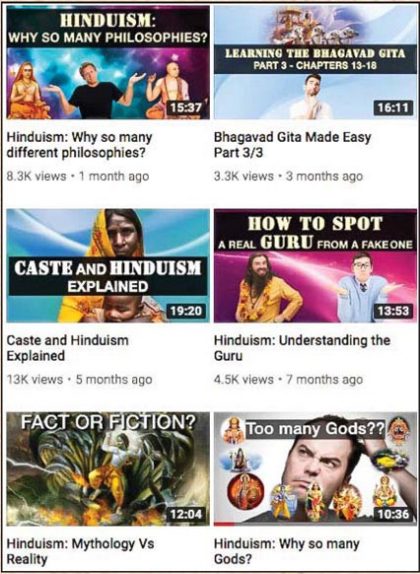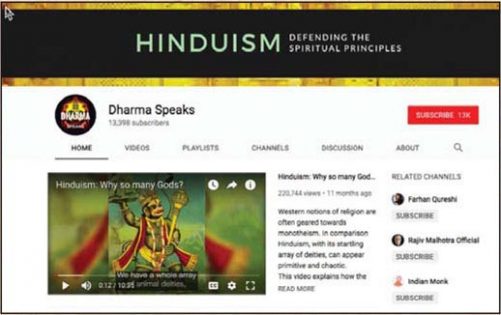YOUTUBE
Tackling Tough Issues
THE MISSION OF THE YOUTUBE channel “Dharma Speaks”(which unfortunately is anonymous) is to clear up common questions and misconceptions about Hinduism, the Sanatana Dharma. Less than two years old, it has a limited number of videos, but each is packed with information, philosophical exploration and vivid imagery, presented clearly in a rational manner.

Hinduism’s many different philosophies are one common source of confusion to non-Hindus. These schools of thought are described here as various time-tested paths one can follow toward the ultimate goal of oneness with God. The narrator explains that by following one of these traditions, we can make reliable progress. Otherwise, it is easy to fall prey to misunderstandings; a lot of new, untested ideas and practices are floating around out there! Though God is unfathomable to the limited mind, the intellect can guide our progress more wisely if it is given a sound frame of reference.

In one video, the apparently conflicting philosophies of Advaita, Vishishtadvaita and Dvaita are likened to the threefold nature of light, which can be seen as a particle, a wave, or both, depending on how it is observed. Likewise, these three philosophies are are different perspectives, different views of God and our relation to God from where we stand in consciousness. Each is valid from its own perspective.
People wishing to malign Hinduism often invoke the caste system. But as one video asserts, today’s birth-based caste system was imposed by the British in order to divide the people of India and solidify their control over the country. Historians might quibble with this characterization. No doubt the British used caste to their own ends and one result of their policies was to make it more rigid, but to say they “imposed” it is a bit of a stretch. This video also depicts the chaos that results from abdicating one’s natural (character-based) varna dharma—as seen today, when governments are guided by corporations rather than by high-minded leaders.
In another video, the purpose, importance and effectiveness of devotional practices, particularly temple worship and the use of murtis (images)—so seldom understood by non-Hindus, are covered in full. The narrator stresses that images and other symbols can be a powerful way to convey deep meaning, and humans of all known cultures have used them to relate to Divinity. Hindu murti worship, particularly in the temple, is deeply meaningful. The temple murti—having been consecrated in the Prana Pratishta ritual—serves as a portal through which God’s grace and presence are experienced. Hindu saints and sages have taught that as long as we have a physical body, we should strive to cultivate humility and devotion through external worship.
A recurrent theme at Dharma Speaks is the difference between book-knowledge and experiential knowledge. Hinduism’s scriptures do not say, “Believe this or else;” they are guidebooks for one’s spiritual practice—and Hindu practices, followed correctly over time, lead to direct personal experience of truth on many levels.
Video resources:
youtube.com/watch?v=uCofNFj3e3I
youtube.com/watch?v=EnJrpQ0HdsE
youtube.com/watch?v=k7q_LtZUJZw
Hear the Gita Being Chanted
LINKS TO ALL 18 CHAPTERS OF THE Bhagavad Gita, beautifully chanted in Sanskrit, can be found at gitachanting.wixsite.com/gita. Each verse is a separate audio clip, with the Devanagari script and the English transliteration.
The clips are hosted on Soundcloud, which seems suited to help youth—and adults—learn other Hindu scriptures as well. Though the person-to-person oral tradition may be nearly extinct, modern technology can go a long way toward making our holy texts accessible to all, far into the future.